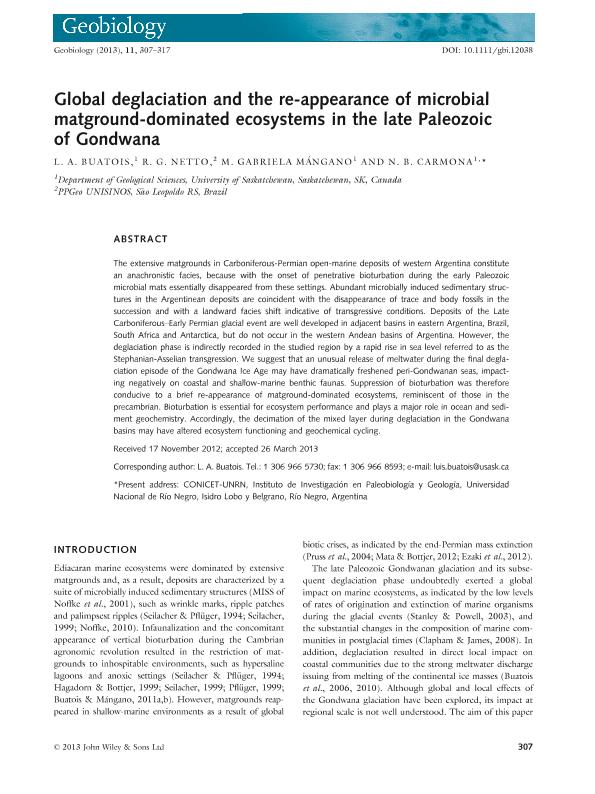Mostrar el registro sencillo del ítem
dc.contributor.author
Buatois, Luis Alberto

dc.contributor.author
Netto, R. G.
dc.contributor.author
Mangano, Maria Gabriela

dc.contributor.author
Carmona, Noelia Beatriz

dc.date.available
2017-06-06T18:01:17Z
dc.date.issued
2013-07
dc.identifier.citation
Buatois, Luis Alberto; Netto, R. G.; Mangano, Maria Gabriela; Carmona, Noelia Beatriz; Global deglaciation and the re-appearance of microbial matground-dominated ecosystems in the late Paleozoic of Gondwana; Wiley; Geobiology; 11; 4; 7-2013; 307-317
dc.identifier.issn
1472-4677
dc.identifier.uri
http://hdl.handle.net/11336/17574
dc.description.abstract
The extensive matgrounds in Carboniferous-Permian open-marine deposits of western Argentina constitute an anachronistic facies, because with the onset of penetrative bioturbation during the early Paleozoic microbial mats essentially disappeared from these settings. Abundant microbially induced sedimentary structures in the Argentinean deposits are coincident with the disappearance of trace and body fossils in the succession and with a landward facies shift indicative of transgressive conditions. Deposits of the Late Carboniferous–Early Permian glacial event are well developed in adjacent basins in eastern Argentina, Brazil, South Africa and Antarctica, but do not occur in the western Andean basins of Argentina. However, the deglaciation phase is indirectly recorded in the studied region by a rapid rise in sea level referred to as the Stephanian-Asselian transgression. We suggest that an unusual release of meltwater during the final deglaciation episode of the Gondwana Ice Age may have dramatically freshened peri-Gondwanan seas, impacting negatively on coastal and shallow-marine benthic faunas. Suppression of bioturbation was therefore conducive to a brief re-appearance of matground-dominated ecosystems, reminiscent of those in the precambrian. Bioturbation is essential for ecosystem performance and plays a major role in ocean and sediment geochemistry. Accordingly, the decimation of the mixed layer during deglaciation in the Gondwana basins may have altered ecosystem functioning and geochemical cycling.
dc.format
application/pdf
dc.language.iso
eng
dc.publisher
Wiley

dc.rights
info:eu-repo/semantics/openAccess
dc.rights.uri
https://creativecommons.org/licenses/by-nc-sa/2.5/ar/
dc.subject
Microbial Mats
dc.subject
Gondwana
dc.subject
Paleozoic
dc.subject
Deglaciation
dc.subject.classification
Paleontología

dc.subject.classification
Ciencias de la Tierra y relacionadas con el Medio Ambiente

dc.subject.classification
CIENCIAS NATURALES Y EXACTAS

dc.title
Global deglaciation and the re-appearance of microbial matground-dominated ecosystems in the late Paleozoic of Gondwana
dc.type
info:eu-repo/semantics/article
dc.type
info:ar-repo/semantics/artículo
dc.type
info:eu-repo/semantics/publishedVersion
dc.date.updated
2015-10-15T19:59:36Z
dc.journal.volume
11
dc.journal.number
4
dc.journal.pagination
307-317
dc.journal.pais
Estados Unidos

dc.journal.ciudad
Hoboken
dc.description.fil
Fil: Buatois, Luis Alberto. University Of Saskatchewan; Canadá. Consejo Nacional de Investigaciones Científicas y Técnicas; Argentina
dc.description.fil
Fil: Netto, R. G.. Universidade do Vale do Rio dos Sinos; Brasil
dc.description.fil
Fil: Mangano, Maria Gabriela. University Of Saskatchewan; Canadá. Consejo Nacional de Investigaciones Científicas y Técnicas; Argentina
dc.description.fil
Fil: Carmona, Noelia Beatriz. University Of Saskatchewan; Canadá. Consejo Nacional de Investigaciones Científicas y Técnicas; Argentina
dc.journal.title
Geobiology

dc.relation.alternativeid
info:eu-repo/semantics/altIdentifier/doi/http://dx.doi.org/10.1111/gbi.12038
dc.relation.alternativeid
info:eu-repo/semantics/altIdentifier/url/http://onlinelibrary.wiley.com/doi/10.1111/gbi.12038/abstract
Archivos asociados
